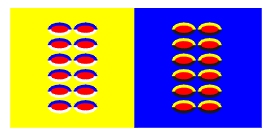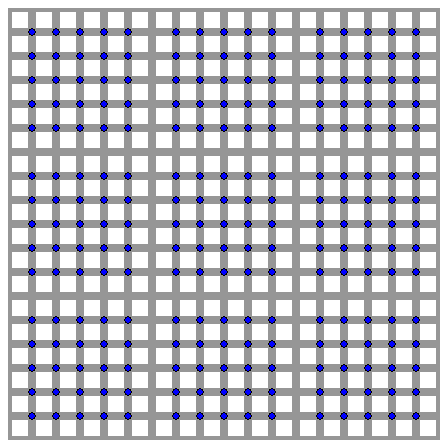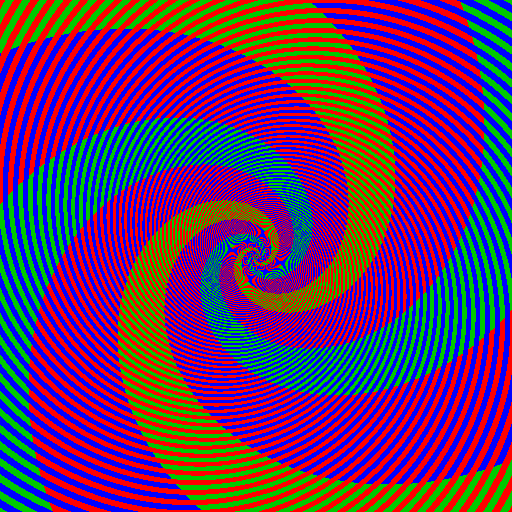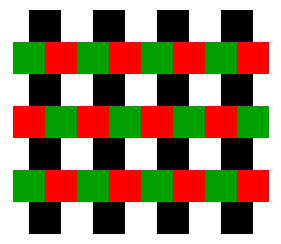Color illusion
Access since September 19, 2004

"Red glasses"
The red glasses in the right columns appear to be different in color from those in the left ones, though they are identical.
Copyright Akiyoshi Kitaoka 2005 (April 18)

"Blue day and blue night"
The blue circles in the upper half appear to be different in color from those in the lower half, though they are identical in color.
Copyright Akiyoshi Kitaoka 2004 (December 17)

"Eye ball"
The red circle appears to move when observers slowly swing their faces. For those who wear concave glasses, the red circle appears to move in the same direction as the swing or the black circle appears to move in the direction opposite to the swing. On the other hand, for those who wear convex glasses, I imagine the direction will be the reversal.
Copyright Akiyoshi Kitaoka 2004 (September 19)
I am sorry that those who do not wear glasses will not have fun.

"Light of sapphires"
Blue dots appear to scintillate.
Copyright A.Kitaoka 2004 (June 18)

"Blue circles"
The blue circles on the block observed in the fovea appear to be surely blue, but they become more white when seen in the periphery.
Copyright A.Kitaoka 2004 (June 18)

"Green and blue spirals"
There appear to be spirals of light green or light blue. Actually, they are identical (r = 0, g = 255, b = 150). I thought the basic illusion is given by Monnier and Shevell (2003), but this image might not match their theory...
Copyright A.Kitaoka 2003

"Red spirals"
There appear to be spirals of two different types of red. Actually, they are identical.
Copyright A.Kitaoka 2002
(c)Akiyoshi Kitaoka "Trick eyes" Tokyo: KANZEN 2002

"Green spirals"
There appear to be spirals of two different types of green. Actually, they are identical.
Copyright A.Kitaoka 2002
(c)Akiyoshi Kitaoka "Trick eyes" Tokyo: KANZEN 2002

"Orochi"*
*Big snakes
There appear to be spirals of two different types of green. Actually, they are identical.
Copyright A.Kitaoka 2003

"The Shonan-shinjuku line"*
*A railway line that connects the north outskirts and the south ones of Tokyo
Although red squares and green ones are aligned, they sometimes appear to be misaligned. The direction of misalignment can be reversed by seeing the figure through the periphery of glasses if you wear them.
Copyright A.Kitaoka 2003

"Enhancement of blue"
Blue circles appear to be enhanced in saturation when seen in the central vision.
Copyright A.Kitaoka 2003

"Ascending dragons"
The red is homogeneous over the figure, but appears to be red-purple behind blue lines or to be orange behind yellow lines.
Copyright A.Kitaoka 2003
There is another appearance that the spirals of illusory different colors appear to be in front of the inducing curves. <January 17, 2010> Thanks to sam

(A remake)

"Gunjo scintillation and ai twinkle"
The blue dots are identical between the left and right figures. The dots of the left figure appear to scintillate reddish blue (gunjo in Japanese) while the dots of the right figure appear to twinkle greenish blue (ai in Japanese).
Copyright A.Kitaoka 2003

"A chinese pattern and color assimilation"
The red appears to be magenta behind the blue lines while the same red appears to be orange behind the yellow lines. Is this kind of color assimilation or neon color spreading?
Copyright A.Kitaoka 2003

"Sakai's color contrast"
The squares of the upper row appear to be gray, but they are tinted as shown in the lower row that exchanges between the left fives and the right fives. This illusion is based upon a finding of Kasumi Sakai's graduational thesis (2003, Department of Psychology, Ritsumeikan University) entitled "Color representation by Land's retinex theory and Belsey's hypothesis" (in Japanese).
Copyright A.Kitaoka 2002

"Flowers"
Red appears to be magenta or orange. This is kind of von Bezold's chromatic assimilation.
Copyright A.Kitaoka 2001